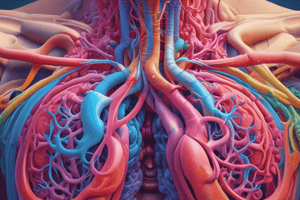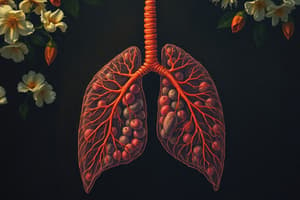Podcast
Questions and Answers
What is another name for the larynx?
What is another name for the larynx?
- Sound chamber
- Wind pipe
- Voice chamber
- Voice box (correct)
What happens to the vocal cords when you speak?
What happens to the vocal cords when you speak?
- They elongate and vibrate.
- They stiffen and stop vibrating.
- They relax and lengthen.
- They contract and vibrate. (correct)
How does the length of vocal cords affect pitch?
How does the length of vocal cords affect pitch?
- All cords produce the same pitch.
- Longer cords produce no sound.
- Shorter cords produce lower sounds.
- Longer cords produce lower sounds. (correct)
What structural feature prevents the trachea from collapsing?
What structural feature prevents the trachea from collapsing?
What structures does the trachea branch into?
What structures does the trachea branch into?
What is the function of cilia in the bronchi?
What is the function of cilia in the bronchi?
What is the primary function of alveoli?
What is the primary function of alveoli?
Why is surfactant important in the alveoli?
Why is surfactant important in the alveoli?
What is the primary function of the human respiratory system?
What is the primary function of the human respiratory system?
What are the two main requirements for respiration to take place?
What are the two main requirements for respiration to take place?
Which part of the respiratory tract is responsible for warming, moistening, and cleaning the incoming air?
Which part of the respiratory tract is responsible for warming, moistening, and cleaning the incoming air?
What is the role of ciliated cells in the nasal passage?
What is the role of ciliated cells in the nasal passage?
Which structure acts as a flap that covers the opening to the trachea during swallowing?
Which structure acts as a flap that covers the opening to the trachea during swallowing?
Why is carbon dioxide considered harmful to the body in high concentrations?
Why is carbon dioxide considered harmful to the body in high concentrations?
What type of gas is NOT a major component of air?
What type of gas is NOT a major component of air?
The main organ of respiration is located in which part of the body?
The main organ of respiration is located in which part of the body?
Flashcards
What's in Air?
What's in Air?
Air consists mainly of nitrogen, oxygen, carbon dioxide, argon, and trace gases.
Why do we breathe?
Why do we breathe?
The process of taking in oxygen and releasing carbon dioxide; essential for cellular respiration.
Cellular Respiration
Cellular Respiration
The process in which cells use oxygen to break down glucose for energy, producing carbon dioxide as a waste product.
What is the respiratory system's function?
What is the respiratory system's function?
Signup and view all the flashcards
Why is surface area important for respiration?
Why is surface area important for respiration?
Signup and view all the flashcards
Why is moisture important for respiration?
Why is moisture important for respiration?
Signup and view all the flashcards
What is the respiratory tract?
What is the respiratory tract?
Signup and view all the flashcards
What structures make up the upper respiratory tract?
What structures make up the upper respiratory tract?
Signup and view all the flashcards
What is the larynx?
What is the larynx?
Signup and view all the flashcards
How does vocal cord length affect voice pitch?
How does vocal cord length affect voice pitch?
Signup and view all the flashcards
What is the trachea's role in the respiratory system?
What is the trachea's role in the respiratory system?
Signup and view all the flashcards
How are bronchi structured?
How are bronchi structured?
Signup and view all the flashcards
What are bronchioles?
What are bronchioles?
Signup and view all the flashcards
What is the primary role of alveoli?
What is the primary role of alveoli?
Signup and view all the flashcards
How are alveoli optimized for gas exchange?
How are alveoli optimized for gas exchange?
Signup and view all the flashcards
What are the key features of the lungs?
What are the key features of the lungs?
Signup and view all the flashcards
Study Notes
Outcome D1b: Respiratory System
- This outcome explains how the human respiratory system exchanges energy and matter with the environment.
Air Composition
- Air is made up of:
- Nitrogen (78%)
- Oxygen (21%)
- Argon (0.9%)
- Carbon Dioxide (0.04%)
- Trace gases (0.06%)
- Oxygen is obtained through breathing into the lungs.
- Lack of oxygen for more than a few minutes can lead to death.
Why Breathe?
- Cells need oxygen for cellular respiration.
- Cellular respiration produces carbon dioxide as waste.
- High carbon dioxide levels are harmful to the body.
- The respiratory system's main function is to take in oxygen and release carbon dioxide.
Respiration Requirements
- Respiration needs a large surface area for efficient gas exchange.
- A moist environment is needed for oxygen and carbon dioxide to dissolve and diffuse across the membrane.
Respiratory Tract: Upper
- The lungs are the primary organs of respiration, located in the thoracic cavity (chest cavity).
- The airway is called the respiratory tract, divided into upper and lower sections.
- The nasal passages warm, moisten, and clean incoming air. Ciliated cells within move foreign particles out of the respiratory tract.
- Turbinate bones increase the surface area of the nasal cavity, aiding in warming and moistening the air, as well as trapping dust particles. Heat from blood vessels in the nasal passages further warms the air.
- The pharynx is the common passageway for air and food.
- The epiglottis is a flap of tissue that covers the trachea (windpipe) to prevent food from entering the airways when swallowing.
- The glottis is the opening to the trachea.
- The larynx, or voice box, contains vocal cords that vibrate to produce sound. The pitch of the voice depends on the length of the vocal cords (longer cords = lower pitch, shorter cords = higher pitch).
- The trachea, or windpipe, carries air to the lungs. It's supported by C-shaped cartilaginous rings to prevent it from collapsing.
Respiratory Tract: Lower
- The bronchi (singular: bronchus) are two branches that extend from the trachea into each lung. They are supported by C-shaped cartilaginous rings for support. The bronchi are lined with cilia and mucous-producing cells.
- Bronchioles are subdivisions of the bronchi inside each lung, and do not contain cartilage. The lining is also lined with cilia and mucous-producing cells.
- Alveoli (singular: alveolus) are clusters of tiny air sacs at the ends of terminal bronchioles. They are the site of gas exchange. Each alveolus wall is extremely thin and is surrounded by a network of capillaries.
- The alveoli have a moist membrane, a large surface area, and thin walls to optimise gas exchange. They are covered in surfactant to prevent the alveoli from collapsing.
- Lungs are divided into lobes (the right lung has three, and the left lung has two).
- The pleural membrane is a double membrane that surrounds the lungs, allowing them to expand and contract with the movement of the chest.
- The diaphragm is a dome-shaped muscle below the lungs that aids in breathing. It works in conjunction with rib muscles to move air in and out of the lungs.
Studying That Suits You
Use AI to generate personalized quizzes and flashcards to suit your learning preferences.




